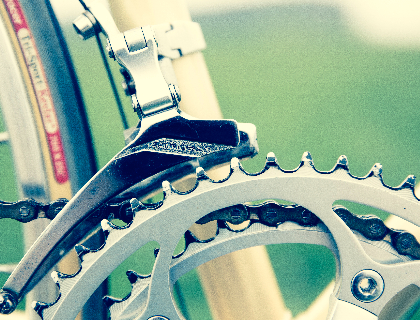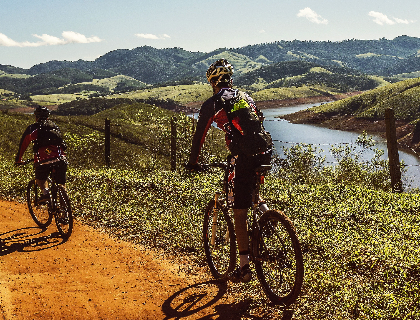Patient experience: How sports journalist Keme Nzerem went from being unable to walk without pain, to mountain biking around Mont Blanc
IN BRIEF - 17TH FEBRUARY 2017
The sound was like a rifle going off. THOCK! I heard my anterior cruciate ligament tear.
I was in a remote village in Gambia on a university field trip, and we’d been given a really boring task—counting cabbages or something. The farmers there were as bored as we were at the thought of it. It took us about 25 seconds to count the cabbages, then we sat down in the blazing African heat and waited. And then someone produced a football. All at once the village stopped, a referee turned up out of nowhere, everyone was cheering. I went to head the ball—but the top half of my leg twisted and the bottom half stayed in the sand.

It was a typical footballer’s injury. The knee is an amazing piece of engineering; a complex set of counterbalances and cantilevers in an intricate mesh of tissue. It is not only very strong—as a joint it supports your whole body weight—but allows for fine movement as well. The anterior cruciate ligament (ACL) is one of a pair of cruciate ligaments which are arranged across the knee in a cross formation. The ACL gets injured when the knee is wrenched in one way or another beyond the capacity of the ligaments to stabilise it. I’ve always played a lot of football—as a 16-year old I was semi-professional—but I’d also always had knee problems, and I didn’t realise how serious the injury was. After I’d recovered, it took a few more times of playing football and damaging myself further before I went to hospital and had the ACL replaced.
It wasn’t particularly good surgery, and the rehab was very poor: I didn’t realise at the time the importance of good physiotherapy. That relationship between your life, your employer and your physiotherapist is crucial, and to rehab from a significant injury cannot just be a case of a half hour session before you go home and do your exercises, which is the typical offering. You need to spend hours and hours in a monitored environment, with someone who knows what they’re doing—who can help you rehab safely and properly. Fast forward a few years and I’m sports correspondent at Channel 4, trying to play football but not competitively, and skiing every year—though I can barely walk after each trip, I am so broken. As the engineering of my knee got more and more damaged, I started to get knock-kneed.
I was introduced to Isokinetic by a friend, who said “go and see these guys because they will revolutionise your understanding of your body and what you can do. If there is a way to get you fit, they will find it.” They worked with me intensively to build my muscle strength back up to the point where I was playing football and skiing: I had a great trip to the Himalayas backcountry skiing two years ago, and I couldn’t have done it without them.
After a while, though, it began to be clear there were various problems in my knees that no amount of muscle training or physiotherapy was going to fix. We were left with three options: the first was to just try and do as much physio as possible, facing the very real prospect of a knee replacement in a few years’ time and a rapidly diminishing ability. The second was to have a knee replacement straight away, on the assumption I would have one before long anyway. The last, which we went for, was surgery to replace the ACL again, and another operation to correct the profound collapse of my left knee: I was valgus to the tune of 22 degrees.
Wearing tight trousers, I looked like a penguin, but most importantly, I couldn’t do my job properly and I was in pain. It’s the nature of the job that we often end up editing in the back of the car: I couldn’t manage even that. I wanted to lead an active life again. I had the two surgeries, which involved pins, plates, bone saws, and lots of morphine. Then, after just five days of lying at home on oxycodone, I started the physiotherapy. I went in every day for three hours, for six weeks.

The qualitative—and indeed quantitative—difference rehabbing at Isokinetic along with an integrated team and other people with similar injuries is just extraordinary. It is so utterly different to the lonely and confused experience I had rehabbing in the past, at home on my own. You don’t know if what you’re doing is right and the impact of that, of course, is that you don’t do it well and are less productive. We do not understand the importance of rehab after injury in this country, but it is in every employer’s interest to find somewhere like this. It takes time, but they will get a happier and far more motivated employee in the end.
The first six or seven weeks were concentrated mainly on reducing swelling and flexibility work. Very repetitive, slow movements with small weights were about all I could do. When you replace a ligament, that ligament has to be drilled into the bone and fixed with glue, then the body, as new bone forms a cement around the ends of the ACL graft, creates its own ‘glue’. If you put too much pressure on this fixing too early on, it pops out, so you need to ensure you get flexibility without straining it. Over time the emphasis began to shift to strength and power work, and I started to build muscle up to stabilise and protect the joint. At the moment, I am in twice a week for long sessions, doing flexibility, core stability and we are now focusing on power, particularly in the left knee.
We will do this for a few more months, then move on to what is called, broadly speaking, dynamic movement. This is when you really start to get moving and running around with a ball, rather than going to the gym. Isokinetic has great facilities: a green room, access to Regent’s Park and Wembley astroturf pitches, and others. The last few meetings have suggested the doctors are confident I will be able to ski the back end of this season, provided it’s not too high octane, so I’ll go with the family. They are happy with both knees structurally, as they are reasonably strong and have a good range of motion, but I have to be realistic about where I am going to end up. Will I be pain-free and able to lead a normal life? Absolutely. I’ll also be able to cycle: cycling is one of the few things that is really good for someone who has knee problems because there is no impact. Will I be able to play football again? I just don’t know.
I have a lot of metal in there now. I have a damaged knee and damaged cartilage. I am certainly not going to be able to perform at the level of football I would want to if I did play. The uneven surface, the possibility of someone clipping my ankles, and my competitive spirit would probably compromise my safety. Cycling is the one thing I can push to the absolute limit, and I’m cycling around Mont Blanc in a few weeks’ time. Scoring a goal is thrilling, but cycling through an amazing mountain landscape or skiing fresh powder that goes on and on? Those are pretty exhilarating experiences, too.
For more information, visit Isokinetic
-
IN BRIEF
Hypermobility
Dr Deane Halfpenny of the London Orthopaedic Clinic on the growing awareness and future prospects of this little-known but potentially debilitating condition.
-
NEWS
A sports medicine doctor on ‘winning health strategies’ at Arab Health 2017
A sports medicine doctor working at FC Barcelona will present on ‘winning health strategies’ at Arab Health 2017
-
FEATURE
Patient experience: salivary stones
How David Kelly discovered a 12mm-wide stone in his throat—and how having it removed changed his life for the better, despite forcing him to miss one of the biggest days of his career